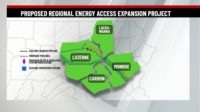The New Jersey Dept. of Environmental Protection has reproposed—now through normal rulemaking and not as an ‘emergency” mandate—rules regulating new and renovated construction in flood-prone inland areas and is updating its flood zones and rainfall data for projects along rivers and streams for the first time since 1999.
The proposal, set for official publication Dec. 5, would elevate habitable first floors 2 ft above what now is indicated on DEP flood maps and 3 ft higher than what FEMA maps show. It would also require use of future rainfall projections and added stormwater management.
According to DEP, precipitation rates are 1% to 15% higher than 1999 data show in the state, and the likelihood of a 100-year storm will rise 24 to 50% in many New Jersey areas in coming decades.
The agency held engagement sessions in October to provide more input from communities, but following official publication, it would seek public comment through Feb. 3, with a hearing set for Jan. 11. A DEP official estimated the proposal could be adopted by the second quarter of 2023.
Gov. Phil Murphy said the rule ”is driven by the challenging realities” of larger and more frequent rainstorms in New Jersey. Hurricane Ida in 2021 brought historic levels of rain and inland flooding that killed 48 people in the state and elsewhere in the Northeast.
DEP Commissioner Shawn LaTourette said earlier that “New Jersey is ground zero for some of the worst impacts of climate change” and “we have no choice but to build our resilience ... and modernize our flood standards."
If adopted, the updated standards would apply to new or reconstructed development and not to existing structures. Pending permit applications at DEP that are administratively complete when the rule is finalized would not be affected by the changes. It also won’t apply to any major development that does not need DEP permits.
To help gauge a project's potential flood risk and "provide a visual approximation of regulatory jurisdiction on specific parcels," DEP has launched a "flood indicator tool." The agency notes that it "does not provide a definitive demonstration of regulatory jurisdiction or calculate actual risk."
Scaled Back From "Emergency'
The proposal dials back in implementation urgency from one proposed under emergency status in June that business and municipal groups opposed because of its immediate impact on projects.
Among groups opposing were the Engineers Labor-Employer Cooperative (ELEC 825), NAIOP, New Jersey Association of Counties, New Jersey Builders Association, New Jersey Concrete and Aggregate Association, New Jersey Society of Professional Land Surveyors, New Jersey State Chamber of Commerce, New Jersey Utilities Association and the Utility & Transportation Contractors Association.
That rule was pulled back but business still has concerns related to the reissued version.
"We have agreed, and continue to agree, that the current standards are outdated and they need to be modified,” said Ray Cantor, a New Jersey Business & Industry Association spokesman. “However, we question if the blanket two-foot increase has a firm scientific basis and is appropriate everywhere.”
He also wants DEP to allow a delay in the rule's effective date for projects now applying for permits, but which may not have broken ground when it becomes final and may be located in new flood zones.
Environmentalists had favored the original emergency status, citing the worsening climate change trends. A coalition said in an Oct. 27 letter to DEP that the rules “are the first step forward,” but are concerned that "the time between proposal and adoption affords developers the chance to rush through projects that fail to meet modern standards.” They want the rule finalized by April 30.
The proposed rules include compliance exemptions for state Dept. of Transportation projects, recognizing "unique challenges associated with new, expanded, reconstructed and improved public transportation infrastructure, which can lead to impracticability of strict compliance with the proposed new standards in this rulemaking” related to road and rail project design, said the proposal.
Projects that have been constructed by private development would not gain such flexibility under the new standards, state officials said.
But that provision was characterized in one local media account as “a balancing act within Gov. Murphy’s administration between regulatory aspirations about climate change and construction demands,” particularly related to potential infrastructure project boosts from new federal funding.
New Jersey’s 2019 Clean Water and Flood Reduction Act allowed, but did not require, municipalities to set up stormwater utilities, NJ Spotlight said in October. But most of the state’s 564 municipalities have opted not to do so, despite increased flood risk and available DEP technical assistance, including funding for feasibility studies.
A New Jersey League of Municipalities official said that claims that a stormwater utility amounts to a “rain tax” on developers "is unfortunate because it can be a very effective tool and saves money in the long run.”






Post a comment to this article
Report Abusive Comment